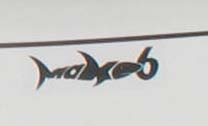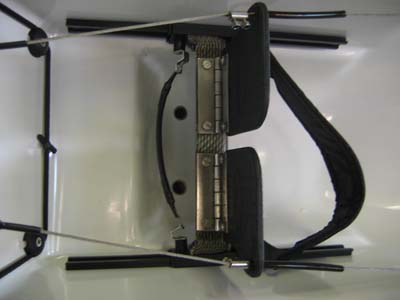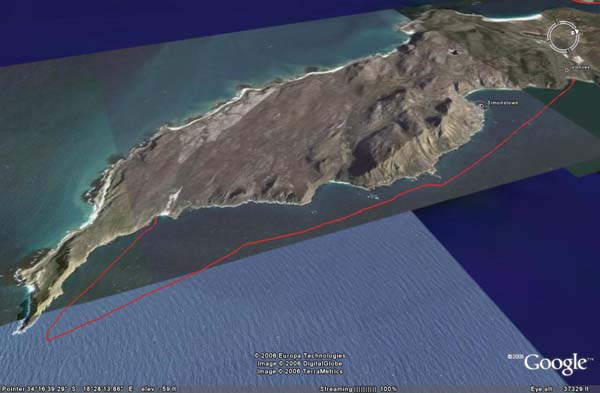Review update: Paddling a Carbon Fenn Mako 6
 I recently bought a Carbon (vacuum bag lay-up) Fenn Mako 6. I’ve had my new ski for nearly five weeks now and have paddled it in a variety of conditions.
I recently bought a Carbon (vacuum bag lay-up) Fenn Mako 6. I’ve had my new ski for nearly five weeks now and have paddled it in a variety of conditions.
I’m astonished at the improvement to my paddling – both in terms of race results and sheer enjoyment.
First Impressions
It's light - just 11.4kg. (The spec sheets say the ski should weigh around 12kg.)
It's sensitive to knocks. The ski was sitting on the car on the roof racks when I opened the boot - and to my horror, the windscreen-washer fitting left a slight dent in the bottom of the ski.
(I later confirmed that these carbon sandwich skis are very susceptible to damage from sharp objects - woe betide you if you put them down on gravel for example.)
Updates
There are some fixes to the problems previously reported, as well as some improvements:
- The extreme narrowness of the rudder pedals. The design of the foot strap has been changed so that there's now another 3-4cm of room.
- The flimsy foot plate. In my ski this has been significantly beefed up and is made of carbon/Kevlar.
- The rudder cables have been moved slightly so that they no longer rub the sides of the cockpit.
- Finally Fenn Kayaks have started producing a new slim-line rudder that is much narrower in cross-section than the older model. Mine is made of Carbon/Kevlar and is extremely light (around 80g of materials excluding the steel shaft).


So what's it like to paddle?
I'd been told that carbon skis were twitchier than their glass counterparts; that this is due partly to the lightness and partly to the increased rigidity of the hull. Since stability was a major factor in my buying the ski in the first place, this was not good news.
However, I haven't found any significant difference in stability between the two versions; I find the carbon ski just as comfortable as the glass version even in the nastiest side-chop.
The Single Footwell
Is the single footwell a problem in terms of filling up with water? When going out through waves, the cockpit fills with water; the ski does feel heavier and the water does noticeably slosh around in the cockpit. And the drainage is not great.
But how much of a problem is this? The ski is maybe 5-10kg heavier getting out through the waves, but once you're past the backline, the water drains quite quickly, and otherwise the ski is dry in my experience. I've not had the cockpit fill on a downwind run (yet).
So for me this isn't really an issue, especially as we don't often have to go out through surf in Cape Town.
Stability
For all my raving about stability, it must be noted that this is not a beginner's ski. The stability is somewhere between a Fenn XT and a Fenn Millennium. A friend who has been paddling a Fenn XT is finding his new Mako 6 quite a handful in choppy water.
But if you've been paddling a Fenn Mako, a Fenn Millennium, a Red7 70 (old version) or an Icon, you'll find the Mako 6 significantly more stable.
Racing the ski
Overnight my race results in the Hout Bay Winter Series have improved by about 5%. This is a huge difference.
The first race was held in classic Hout Bay winter conditions - not much wind but chop, caused by deep sea swell ricocheting off the sides of the bay, going in all directions. On my previous ski I'd have been wasting half my energy staying upright. On the 6, I was head down focussing all my effort into moving forwards. Result: my fastest average speed ever for a non-downwind race of 11.4km/h. In those conditions, astounding.
Since then we've had two other races, one in flat conditions. In both I finished far higher up the order than usual.
Having fun on the ski
Last weekend I found myself paddling downwind in a north-easterly near Simonstown harbour wall. The waves were hitting the wall head on and were being reflected with almost 100% energy straight back into the bay. The chaotic sea conditions near the wall can be imagined.
The stability of the ski meant that even in the slop I was able to power onto the waves heading towards the wall and crash through the oncoming reflections. It felt as though I was going through a set of rapids, the ski was bucking and leaping and spray was flying everywhere. Awesome fun!
Buffels Bay to Fish Hoek via Cape Point
But the truth really sank home this weekend when my paddling buddy Damian and I paddled a solid 32km haul from Buffels Bay to Fish Hoek by way of Cape Point.

The Southeaster was blowing a fair 15-20kts in False Bay (in mid-Winter no less, talk about unseasonable weather) and conditions looked good for a downwind run. I wanted a good long paddle, so we chose the route accordingly.
The first section, from Buffels to the Point saw us going straight into the wind over some fairly large 3-4ft waves that had a nasty cross component. Had I been paddling my old ski, I'd have had my heart in my mouth and I'd have been bracing frequently to stay on. As it was, I was completely relaxed, focussed simply on warming up.
Conditions near the Point were challenging. As we turned downwind we found that there were small waves moving in the same direction as the wind with much larger waves running at almost ninety degrees to our course. So we could catch the small runs and then turn onto the bigger ones.
We wanted to stay out to sea in order to stay away from the notoriously choppy water between Buffels Bay and Smitswinkel Bay but inevitably, as though attracted by some invisible force, we ended up exactly where we didn't want to be - right in the messy bumpy seas off the cliffs south of Smitswinkel Bay. It was here where it came home to me just what a difference stability makes.
Damian was making painfully slow progress, literally snatching strokes between braces. I was enjoying a completely different experience of the same water. I was so stable and comfortable that I was literally paddling rings around him. I'd paddle alongside him for a while, then catch some waves, get a hundred or so metres ahead, then turn and paddle a circle into the wind, finishing alongside him again.
By the time we got to Millers Point, Damo was exhausted, having spent all his energy battling the choppy conditions. Thanks to the 6's stability, however, I was still relatively fresh.
Conditions were great for a Millers run - and I took off, agreeing to meet Damo at the lighthouse. When I got there, I hit the lap button on my GPS to record the time, then turned and paddled upwind for 2 ½ minutes to find Damian. Going past the lighthouse for the second time, I hit the lap button again to record my time from there to Fish Hoek.
When I got to Fish Hoek, I checked my total elapsed time from Millers Point. The result: 51:40
Which meant that even having paddled for nearly two hours already, I achieved a new Personal Best time for the Millers Run.
I ascribe this to three things:
- The 6 is so stable and comfortable that I was able to cruise for two hours (even through extremely rough conditions) and still feel fresh.
- The 6 is an excellent downwind performer
- I'm not unfit. But it should be noted that I haven't been training nearly as hard as I did for the Cape Point Challenge and my race result then was extremely disappointing.
Summary - the negatives
The only reservation I have about the carbon ski is its susceptibility to puncture damage. I'm totally confident about its structural strength, but I know I can't just bang it about like a glass ski. I've installed Thule kayak cradles on my roof-racks and invested in a padded ski cover. I feel I should buy a glass ski for training and unwrap the carbon ski only for races!
The cost of the ski (more than double the glass lay-up) is also an issue. Is it worth it? All I can say is that I love this particular ski - I don't know whether the improvements to my paddling would be the same on a glass ski. We hope to investigate the differences between regular skis and their ultra-light equivalents in the coming months (a friend just bought a V10L Ultra that weighs less than 10kg).
Summary - the positives
The old adage, "it's the paddler, not the ski, that counts", is simply no longer true. For a B-grade paddler like me, who likes to paddle in rough conditions, stability counts an enormous amount.
There is no doubt that for me the 6 is a very fast ski. This may simply be because the stability (and comfort) allows me to focus more energy into moving forward than before, but whatever the reason, I feel that I now have a ski on which I can aspire to become an A-grade paddler. I can no longer use the ski as an excuse!
But, perhaps much more important than its speed or racing performance, the Mako 6 is just incredibly fun to paddle.

